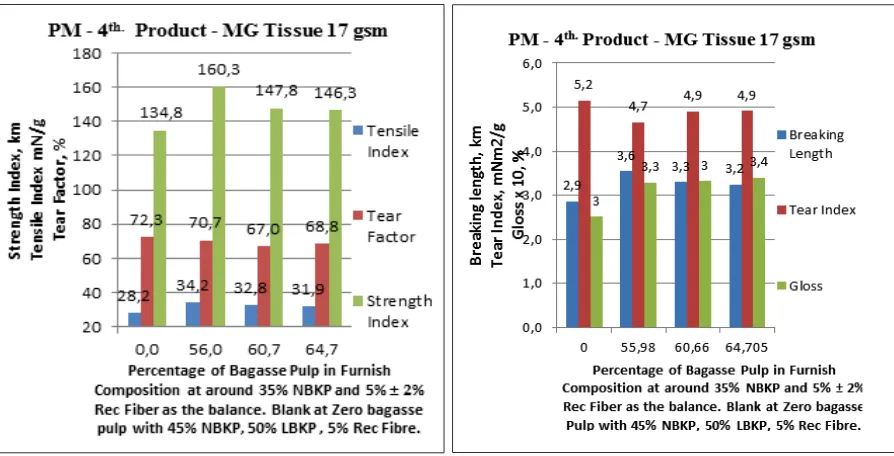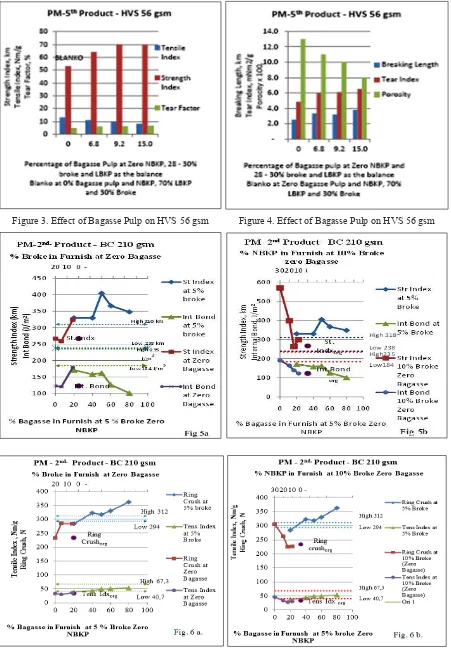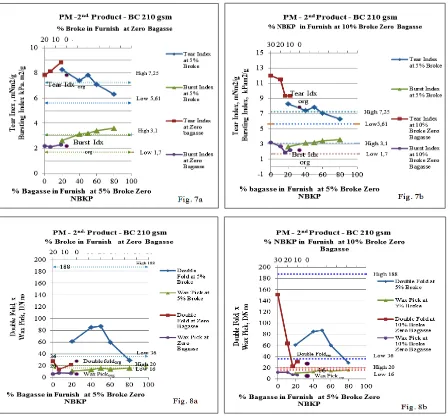THE USAGE OF BAGASSE PULP FOR WOOD FIBER SUBSTITUTION
IN PAPERMAKING
Darono Wikanaji a *, Trismawati b **, Pepi Kartiko c
a,b Panca Marga University, Jl. Yos Sudarso 107 Pabean Dringu, Probolinggo 67271, Indonesia * [email protected], ** [email protected]
cPT Kertas Leces (Persero), Jl Raya Leces - Probolinggo, Indonesia; [email protected]
Diterima : 6 September 2012, Revisi akhir : 27 Desember 2012
PENGGUNAAN PULP BAGAS UNTUK SUBSTITUSI SERAT KAYU PADA PROSES
PEMBUATAN KERTAS
ABSTRAK
Penelitian pulp bagas virgin dan bagas pasaran sebagai bahan baku pembuatan kertas tisu gramatur 17 g/m2, kertas HVS 56 g/m2, dan karton BC 210 g/m2 dalam rangka substitusi serat LBKP dan NBKP telah dilakukan. Kertas tisu MG yang dibuat di PM4 pada kecepatan 3,2 % lebih rendah dan 6,7 % kapasitas lebih rendah ternyata mampu mensubstitusi seluruh porsi LBKP (60%) tanpa efek negatif
pada sifat fisik kertas. Kertas HVS dibuat di PM5 pada kecepatan 4,3 % lebih rendah dan kapasitas 1
% lebih rendah ternyata mampu meningkatkan indeks kekuatan, indeks tarik, dan indeks sobek, serta mengurangi porositas hingga 800 ml/mnt. Karton BC dibuat di PM2 pada kecepatan dan kapasitas yang sama ternyata mampu mensubstitusi porsi LBKP (40 – 80 %) dan NBKP (10 – 20 %) tanpa pengaruh
negatif pada sifat fisik. Tetapi sifat BC masih berada diantara batas bawah dan batas atas BC komersial,
meskipun ada penurunan tajam pada indeks kekuatan dan ketahanan lipat dibandingkan dengan BC yang menggunakan 20 – 30 % NBKP.
Kata kunci : pulp bagas, indeks tarik, indeks kekuatan, indeks sobek, porositas
ABSTRACT
Research of virgin bagasse pulp and market bagasse pulp as the furnish for MG tissue 17 gsm, HVS paper 56 gsm, and BC paper 210 gsm has been done for NBKP and LBKP substitution. MG
tissue was produced on PM 4th at 3,2% lower speed and 6,7% lower throughput is able to replace the
whole LBKP portion (± 60%) with no negative effect on physical properties at all. The use of bagasse
pulp up to 15% to substitute LBKP in the furnish of HVS produced on PM 5th. at 4,3% lower speed and 1% higher throughput is able to improve strength index, tensile index, and tear index, and reduces the
porosity up to 800 ml/minute. Bagasse pulp for BC paper was produced on PM 2nd. at the same speed and
throughput is able to replace some portion of LBKP (40 – 80%) and NBKP (10 - 20%) with apparently no negative effect on physical properties. But, properties of BC still on between the high and low level
properties of BC available on the market, even though a sharp decrease of strength index, tear index and
double fold has been found when compared to BC 210 gsm using 20 - 30% NBKP.
Keywords: bagasse pulp, tensile index, strength index, tear index, porosity
INTRODUCTION
Wood demand for pulp and paper industries
has increase significantly since some decades ago.
This everlasting condition seems goes increase further in the incoming years. The Indonesian annual installed pulp production capacity has
grew up significantly from 1 million tons in
1990 to nearly 6.5 million tons in 2009 and it is
estimated will up to around 7 million tons in 2015 (Poyry Consulting, 2012). This mean the wood resources needed will be around 34.6 million m3
of round woods or around 25 ton of round wood
degradation goes up continuously with the rate of
degradation around minus 2 % per year in Asian
countries especially in Indonesia. These were
happened because of the conversion of forest to non-forest, forest to plantation, and decrease of forest canopy hardly controllable continuously
happened and the HTI allocated area for sawn wood, pulp and paper, and even HTI Trans not yet
planted effectively except for HTI Pulp at Jambi. The rapid expansion of pulp and paper industries in Indonesia has underlying the development of HTI concessions but does not effectively manage yet (Emily Matthews, 2002).
What had been done by PT Kertas Leces (Persero) as a trendsetter in using bagasse
pulp as one constituent on its raw material in
producing its products since more than 30
years ago and rice straw pulp since more than 80 years ago were mentioned even though this
everlasting product should be ended in the mid of 1990’s because of economic and policy situation, but the effort back to bagasse pulp
for its raw material or other nonwood pulp for
specialty product is everlasting.
Using bagasse pulp as the only raw material will not be able to produce a good quality of paper but acceptable quality still possible. On the other
hand using bagasse pulp as the main constituent
with other wood pulp as the balance of the raw material will be able to get a good quality and some special quality of properties of product.
Literature Review
The raw material of bagasse pulp and wood pulp (hardwood pulp and softwood pulp) has very
different properties. The physical and chemical
characteristic is quite different.
Raw Material Properties
The quite wide range properties of bagasse and so does hardwood and softwood will give
effect on the physical properties of the pulp produced. Increasing tree age, the amount of cellulose, extractives and lignin are increases but the amount of hemicelluloses and ash decreases (Kasmani et al, 2011)
Table 1.Chemicals Properties Several Raw Material
Compound Bagasse, % Eucalyptus camaldulensis (6 – 10 years old)4, %
Acacia mangium,
(7 year old), % Spruce and Pine, %
Cellulose 42 – 45 38 – 46 45 – 48 39,5 - 40 Hemicellulose 28 – 33 16 – 27 28 – 30 28,5 – 30,4
Lignin 17 – 22 18 – 24 23 – 24 27,5 – 27,7
Extraction 2 – 3 2 –5 3 – 4 2,1 – 3,5
Ash 1.1 – 2.1 0.43 – 076 Na na
Table 2. Physical Properties of Bagasse Pulp, LBKP (Acacia and Euca),
and NBKP (Spurce Softwood Pulp)
Properties Acacia Pulp Euca. c. Pulp Bagasse Pulp EPCO
Bagasse Pulp under
studied Spurce Pulp Freeness, CSF / SR 400 / 32 400 / 32 400 / 32 400 / 32 400 / 32 Brightness (% ISO) > 88,5 89,5 79,3 80 89,75
Bulk (cm3/g) 1,41 1,29 1,24 1,33 1,24
Tensile (N.m/g) 62,22 44,75 41,57 37,95 87,8
Tear (mN.m2/g) 7,97 10,0 6,86 3,70 10,1
Pulp Properties
The physical properties of non wood pulp, hardwood pulp and softwood pulp are also quite deference. Below are some of them on Table 2.
Paper Quality
Many researches had been done in producing
some quality of paper product. Some of them are
listed on the Table 3.
Experimental / Operational
The raw material used is the existing pulp
normally used at PT Kertas Leces (Persero).
The composition variation was suited for every
product under examination. The product under
examination was categorized under tissue paper, industrial paper, and writing printing paper.
The evaluated composition for every category of paper is suited for the recommended paper
quality of product and paper machine run ability
that should be maintained. Other operational variable except furnish composition kept constant in every experiment. In case of any process
disturbances as a result of furnish drain ability
the only allowable adjustment is speed reduction
in order to maintain the paper machine run ability
to keep the constant throughput. The result was compared to any product quality on the market with the properties as follows (Table 4).
RESULT AND DISCUSSION
In case of MG tissue paper category, the
examined product was MG tissue 17 gsm with
45 % NBKP and 50 % LBKP, and 5% Recycle
fiber as the original composition. Previously, paper machine speed was 627 mpm with average
total throughput 30 ton/day. The adjusted furnish
composition under examination was bagasse pulp 60 ± 5% to substitute all LBKP portion, recover fiber 5%, and the rest was NBKP as a balance to
reach 100% composition. In this case the NBKP
portion was only 35% as an alternative of 45% previously. The adjusted speed was 607 mpm with average total throughput was 28 ton/day (3,2% lower speed and 6,7% lower throughput). It seems that wet sheet drain-ability was the major drawback that had forced the machine attendance
to decrease the machine speed. The results are Table 3. Quality of Paper Product Use Bagasse Pulp
Bagasse Pulp and Long Fiber Virgin Woodpulp
Type of Paper Bagasse (%) Long Fiber Pulp (%) Quality
Corrugating medium 90 10 Excellent
Lightweight MG wrapping (1) 65 – 75 25 – 35 Good
(1) Bleached or unbleached.
(2) Select kraft wastepaper could substitute a portion of the long fiber virgin woodpulp.
(5) Bleached chemimechanical or high-yield chemical pulp used for part of bagasse furnish.
Table 4. BC 210 GSM Quality Properties Available on The Market
Figure 1. Effect of Bagasse Pulp on MG Tissue Properties
Figure 2. Effect of Bagasse Pulp on MG Tissue Properties
as follows (figure 1 and figure 2). From figure 1 and figure 2, it can be concluded that bagasse
pulp might substitute some portion of LBKP and reduce the amount of NBKP for at least 10%.
The original composition (blank) was bagasse
pulp 0%, NBKP 45%, LBKP 50% and recovered
fiber 5%. The examined composition variation was bagasse pulp 56%, 61%, 65%, NBKP around 35%, and recovered fiber ± 5% as the balance. The MG tissue 17 gsm properties achieved is
quite resembles with tensile index,strength index, breaking length, and gloss is higher when using
bagasse pulp to substitute some portion of LBKP and NBKP, but the tear factor and tear index is a
little bit lower.
In case of writing and printing paper category that was produced at PM 5th, the examined
product was HVS 56 gsm with 70 % LBKP and 30 % broke fiber as the normal composition. The original paper machine speed was 578 mpm with average total throughput 187 ton/day. The
adjusted furnish composition under examination
wass LBKP ± 60%, bagasse pulp ± 10%, NBKP 0%, recovered fiber 30% to reach 100% composition. The adjusted speed was 556 mpm with average total throughput was 190 ton/day (3,8% lower speed but 1,6% higher throughput). The result is as follows (figure3 and figure 4) In this case seems that again the same drawback
had happened again such as in the MG tissue production at PM 4th, wet sheet drain-ability had force the machine attendance to reduced the
machine speed, but fortunately the throughput could be kept constant and even a little bit higher.
From figure 3 and figure 4, it can be concluded
that bagasse pulp might substitute some portion of LBKP. The original composition (blank) is bagasse pulp 0%, NBKP 0%, LBKP 70% and
recovered fiber 30%. The examined composition was variation of bagasse pulp 7%, 9%, 15%, recovered fiber 28-30% and LBKP as balance
to reach 100% furnish composition. The HVS
56 gsm properties achieved is quite resembles with tensile index, strength index, tear factor, tear index, breaking length are higher when
using bagasse pulp to substitute some portion of
LBKP, but the porosity is lower than before as the prerequisite of this base paper.
In case of industrial paper category, the
examined product was BC Paper 210 gsm, The original composition (blank) was bagasse pulp
0%, NBKP 10-15%, LBKP 70-80% and recovered
fibre 10%. The paper machine speed kept constant
and 150 mpm and average total throughput 70 ton/day. The adjusted furnish composition under
examination were such follows: (i) LBKP ± 15, 35, 45, 55, 75%,bagasse pulp ± 20, 40, 50, 60, 80% and recovered fibre 5% to reach 100% composition with zero NBKP as the first trial and (ii). NBKP 10, 15, 20, 30%, LBKP = 60, 70, 75,
Figure 3. Effect of Bagasse Pulp on HVS 56 gsm Figure 4. Effect of Bagasse Pulp on HVS 56 gsm
LBKP 60, 70, 75, and 80% as a balance to reach 100% furnish composition
Examining and comparing figure 5a and 5b, 6a and 8b, 7a and 7b, and so did for figure 8a and
8b. It is clear that bagasse pulp able to substitute a certain portion of LBKP (up to 50%) and NBKP (up to 20%) to get the accepted properties of strength index and internal bond (higher than the high standard of strength index on the market and
a little bit lower than the low standard in case of internal bond even not so much decreased was happened) such as presented on figure 5a and 5b.
In case of ring crush and tensile index, bagasse pulp able to substitute LBKP portion up to 80%
with higher ring crush and tensile index were
resulted. It is also able to substitute NBKP portion
up to 30 % with the resulted ring crush and tensile index is far higher (figure 6a and 6b). Presented
pulp substitute for LBKP on the properties of BC 210 gsm and Figure 5b- 6b. Effect of bagasse pulp substitute for NBKP on the properties of BC 210 gsm. Figure 7a - 8a. Effect of bagasse pulp substitute for LBKP on the properties of BC 210 gsm and Figure 7b- 8b. Effect of bagasse pulp substitute for NBKP on the properties of BC 210 gsm. From figure 5a, 5b up to figure 8a, 8b, it can be concluded that bagasse pulp might substitute some portion of LBKP and even for NBKP to
reach certain properties of paper. The first trial of the examined composition was the variation
of bagasse pulp 20%, 40%, 50%, 60%, and 80%;
recovered fibre 5%; zero NBKP, and LBKP 15%,
35%, 45%, 55%, and 75% as the balance to reach 100% furnish composition. The second trial of
the examined composition was Zero Bagasse, recovered fibre 10%, NBKP 10, 15, 20, 30%; and
on figure 7a and 7b, substitution up to 50% LBKP with bagasse pulp kept the tear index above the
high standard of tear index on the market but the bursting index incline higher even the substitution
reach 80%. Substitution up to 30% of LBKP with
NBKP the resulted tear index is far higher but this is not compulsory because the tear index is much far higher than the necessary high standard of tear index on the market. In case of bursting index, using bagasse pulp is far better than NBKP. The
same result was examined in case of double fold and wax pick test.
CONCLUSION
1. The use of bagasse pulp as the furnish constituent for MG tissue paper 17 gsm produced on PM 4th. able to substitute the
whole LBKP portion (± 60%), apparently has
no negative effect on the physical properties of MG tissue 17 gsm product.
2. The recommended composition for MG tissue 17 gsm is 60% bagasse pulp, 35% NBKP and
5% recovered fiber.
3. The use of bagasse pulp up to 15% to substitute LBKP in the furnish constituent for HVS 56 gsm produced on PM 5th at 4,3% lower speed and 1% higher throughput able to improve strength index, tensile index, and tear index several point, and reduces the porosity reach 800 ml/minute.
4. The recommended composition for base paper HVS 56 gsm is 15% bagassse pulp, 30%
recovered fiber, and 65% LBKP.
5. The use of bagasse pulp as the furnish constituent for BC paper 210 gsm that produced on PM 2nd at the same speed and throughput able to substitute some portion of LBKP (40% –
80%) and NBKP (10% - 20%) with apparently
no negative effect on its physical properties. In case of strength index and internal bond, bagasse pulp able to substitute certain portion of LBKP (up to 50%) and NBKP (up to 20%) to get the accepted properties of strength index and internal bond. In case of ring crush and tensile index, bagasse pulp able to substitute
LBKP portion up to 80% with higher ring crush and tensile index were resulted. It is also able to substitute NBKP portion up to 30 % with
the resulted ring crush and tensile index is far higher.
6. Properties of BC 210 gsm of PM 2 still on
between the high and low level properties of BC
210 gsm available on the market, even though a sharp decrease of strength index, tear index and
double fold has been found when compared to
BC 210 gsm use 20% - 30% NBKP.
7. The recommended composition for BC 210 gsm is 50% bagasse pulp, 45% LBKP and
recovered fiber 5% maximum.
8. The use of NBKP is not necessary in case bagasse pulp is used as the main constituent,
but NBKP will be recommended for maximum
20% in case on the absent of bagasse pulp in the composition.
REFERENCES
Anonym, Innovation of Bagasse in Pulp & Paper Industry, Pulp and paper – Technology.com, Ochre Media All Rights Reserved, 2001-2013.
Emily Matthews, Charles Barber, Restu
Achmaliadi, Togu Manurung, et. al. The
State of the Forest: Indonesia, WRI, 2002.
Fenta, D. T., The Economic significance of using bagasse as a resource of raw material for pulp
manufacturing – A case study, Research report of University of South Africa, 2010.
FWI/GFW, 2002, The State of the Forest: Bogor, Indonesia: Forest Watch Indonesia, and Washington DC: Global Forest Watch.
Hurter, P and Robert W, 2001, Non wood Plant fiber uses in Papermaking, Non Wood Fiber
Short Course Notes, 2001.
Kasmani J. E., et all. Studying the Effect of the Age in Eucalyptus camaldulensis Species on Wood Chemical Compounds Used in Pulping Process., American-Eurasian J. Agric. & Environ. Sci., 11 (6): 854-856, 2011.
Kocurek, M. J., Hamilton, F., and Leopold, B., 1993, Secondary Fiber and Non-Wood Pulping – Pulp and Paper Manufacture, Vol. 3, TAPPI.
Otto Miettinnen and Harri Lammi, A Study on the Finnish involvement in Industrial Pulp Plantations in Indonesia: Riau Andalan Pulp and Paper (Sumatra) and Finnantara Intiga (Borneo). Friends of the Earth-Finland in consultation with WALHI/ Friends of the
Earth-Indonesia,WRM, 2002




